Last updated: June 6, 2023
Article
50 Nifty Finds #27: A Distinction Without a Difference
Although earlier uniforms were authorized, the first official National Park Service (NPS) uniform regulations were issued on March 20, 1920. Among other things, they included hand-embroidered insignia for the right sleeve of the uniform coat to identify the rank and position of the employee. As far as the public was concerned, however, sleeve insignia was a distinction without a difference. Like today, early park visitors approached anyone in a NPS uniform. Within the NPS it wasn't long before voices questioned the usefulness of the insignia. Even after the uniform committee recommended eliminating them in 1925, it was almost 15 years before they—and the "officers and men" idea they embodied—were officially removed from the uniform regulations.

Officers and "Men"
The 1920 uniform regulations identified three categories of employees to wear sleeve insignia: directors, officers, and rangers. The basic design for directors was four maple leaves. The NPS director insignia featured a gold star in the center while assistant directors had a silver star.
The basis of the design for most officers was oak leaves, three for chiefs and two for assistants. The oak leaves were a "shaded golden yellow" with "dark-brown" branches. Other design elements were placed on or within the oak leaves to represent different jobs and ranks.
- Superintendents: three "golden-brown" acorns over three oak leaves
- Assistant superintendents: two acorns over two oak leaves
- Clerks: white ink bottle and quill over two oak leaves
- Chief electricians: white lighting bolts within three oak leaves
- Electricians: white lighting bolts within two oak leaves
- Chief engineers: white triangle and square over three oak leaves
- Engineers: white triangle and square over two oak leaves
For some reason, the forester sleeve insignia placed white crossed axes over three sequoia cones within a foliage wreath (the chief ranger insignia) rather than on oak leaves.
The design for the rangers was based on a wreath. Sequoia cones denoted the relative positions of the various permanent rangers.
- Temporary rangers: "dark green" wreath only
- Permanent rangers: one "light-brown" sequoia cone with "dark-brown" details and branches within the wreath
- Assistant chief rangers: two sequoia cones within the wreath
- Chief rangers: three sequoia cones within the wreath.
NPS Landscape Engineer D.R. Hull, stationed at Yosemite National Park, drew at least some of the sleeve-insignia designs. Although defined in the 1920 contract, it appears that none were ordered before April 5, 1922, when a contract was awarded to Virginia company F.J. Heiberger & Sons. By the time that contract was awarded, more sleeve insignia had been created:
- Supervisors: white wheel over three maple leaves
- Assistant supervisors: white wheel over two maple leaves
- Chief clerks: white ink bottle and quill over three oak leaves
Another insignia was created by removing the white lighting from the electrician insignia, leaving two oak leaves in the circle. This "generic" insignia was combined with embroidered titles to provide separate insignia for the park naturalists, chief buffalo keepers, and park physicians. “Game Warden” could also be added to beneath any insignia but no examples are known to survive.
The insignia was to be worn between the elbow and the shoulder on the right sleeve. They were hand embroidered on matching NPS uniform material. All were to be 2-1/4 inches in diameter with a 1/8-inch "light-green" border. Cost ranged from $0.36 for temporary ranger insignia to $2.10 for forester insignia. Those worn by the director, assistant director, and engineers cost $1.75 each. The words were charged at $0.80 per letter. The embroidered circles around the central images were specified as light green. Surviving examples with dark-green circles are believed to be from later orders or perhaps different manufacturers. Heiberger & Son, Inc. subcontracted to the General Embroidery and Military Supply Company (known as GEMSCO), New York City, to make them.
The Backlash Begins
About six months after the 1922 contract was awarded, the Washington Office sent a survey to parks regarding different aspects of the NPS uniform, including whether the sleeve insignia were “satisfactory.” Although many responses indicated that they were “fine” or “OK,” several superintendents expressed their dislike of them.

On December 18, 1922, Thomas Boles, superintendent of Hawai‘i National Park wrote,
As to the sleeve insignia: the acorn, pinecone, etc. belong more to the Forestry Bureau of the Department of Agriculture and as our bureau’s distinctive feature is scenery, I believe we should confine our emblem to our "stock in trade," and have suggested that we use a snow-capped peak, with blue water in the foreground, and a red sky (indicating either sunrise or sunset) as a background. Of course, if I wished to be selfish, I would insist that a wisp of smoke be shown floating from the summit of the mountain.
Roger Toll, superintendent at Rocky Mountain National Park, noted that “the sleeve insignia have so much general similarity at a distance that they do not fully serve their purpose.” A chief ranger noted, “The present sleeve insignia mean nothing to the public.” Frank Pinkley, custodian of the Southwestern National Monuments, continued that theme. He didn’t think the sleeve insignia were necessary. In his inimitable style, he expressed,
The force in a park is so small that each employee knows the status of all the others. The visitor doesn’t care whether the chief ranger wears a pair of crossed cactuses with a shovel rampant, while the ranger wears only one cactus and two shovels and the temporary ranger wears a pick couchant; what the visitor wants is a ranger, and he promptly picks him out by his shield-shaped badge and goes and pours his woes in his ears. The fact that it is the third assistant ranger he is talking to means nothing in his young life.
Despite the perspectives of these influential superintendents, the patches remained part of the uniform—and new ones continued to be added. Another contract for sleeve insignia was awarded to F.J. Heiberger & Son, Inc. in March 1924. The "unclassified" insignia created by removing the lightning bolts from the electrician insignia was to be used by all uniformed officer personnel not otherwise covered under the regulations. At the Eighth National Park Conference at Mesa Verde National Park in October 1925, the uniform committee recommended that "no distinction be made between 'officers and employees' with reference to uniform regulations" and the NPS should "omit the brassard (or sleeve insignia) from all uniforms."
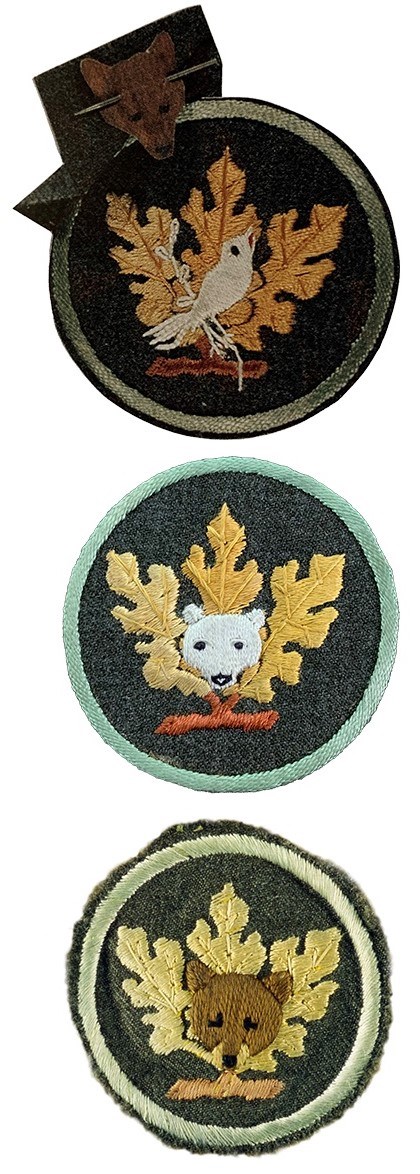
The Naturalists Come to Bear
Unhappy with the generic park naturalist sleeve insignia created in 1922, naturalists preferred the unclassified insignia that became available in 1924. On March 13, 1925, Chief Naturalist Ansel F. Hall sent a letter to Director Stephen T. Mather stating, “In talking with men from various national parks I find that there is no distinctive insignia for the park naturalists and other men engaged in education work.” He submitted a design suggesting, “This insignia be adopted as the emblem of the Educational Branch of the Service and that no difference in rank be indicated. All of the men engaged in this work are scientists and men of education, and I do not want any of them to feel that they are being brought under an ‘officers and men’ regime.” Assistant Director Arno B. Cammerer’s response on March 19, 1925, indicates that the design featured an eagle. The design was returned to Hall with suggestions for improving it to get a better end product and a reminder that the standard color for the circle was light green.
The eagle was abandoned in the redesign. Instead, two new designs—one featuring a bird and the other a bear’s head—were sent to GEMSCO in September 1925. The NPS requested that the bird and bear’s head be created with brown thread. In his book Badges and Insignia, 1894-1991, R. Bryce Workman recounts that the company was out of brown thread at the time and used white instead. The basis for that story is unknown. When delivering the samples, GEMSCO wrote, “We notice that there was an error. Our embroiderer employed the use of white silk instead of brown, and it appears to us that this would give a more striking appearance than if embroidered in the brown. However, this will give you an idea as to what we intend to furnish and whether you select the white or brown, we estimate the cost on a quantity of thirty, $1.80 each.” There is no mention of being out of brown thread. Given that the white thread was in keeping with the earlier insignia they provided, it would seem that someone made an assumption and didn't read the specifications.
Cammerer sent Hall the samples, noting the animals would be made in brown thread, and asking for his thoughts. Hall responded on November 19, 1925, that they “seem to be very unsatisfactory. Both the bear’s head and the bird lose so much by being thus reproduced that they seem almost unrecognizable to the public and unattractive to the naturalists who are to wear them.” He determined that a simpler design was needed.
By January 1926, however, Hall wasn’t happy with any of the alternative designs. He settled on the bear’s head design, with modifications. The shape of the bear's head was made less round and the snout was emphasized. In addition, the eyes were to be triangular instead of round. He drew a corrected version and returned it to Washington.
Cammerer received a new sample from GEMSCO and sent it to Hall for approval on January 22, 1926. Cammerer wrote, “We asked the manufacturer to take extreme care in making the bear’s head, which apparently has been done, and it would seem that further effort to perfect the design would be futile. The design seems to me to be very good, and I wish you would return the insignia for use as a sample in ordering a supply in the event that it is satisfactory to you.” Hall called the sample, “The best we have had yet.” Although he authorized the design, he couldn’t resist adding, “The only suggestion that I have is that the bear’s cheeks (just under the eyes) be made not quite so fat.” A surviving example in the NPS History Collection suggests that efforts were made to streamline the bear’s cheeks by using a lighter color thread to distinguish the snout.
Hall received the first six park naturalist insignia in March 1926. The first four were issued to park naturalists Carl P. Russell (Yosemite National Park), Floyd Schmoe (Mount Rainier National Park), Edmund J. Sawyer (Yellowstone National Park), and Hall himself.
Interestingly, it wasn’t until May 18, 1926,—two months after the insignia was created—that Acting Director Cammerer wrote to Albright and Yosemite Superintendent W.B. Lewis asking for their opinion on a proposal to designate park naturalists as officers. He also supported a proposal to make chief rangers and assistant chief rangers officers and believed “we are wrong in including all clerks in the officers’ rank.” His proposed list of officers reduced the number to 11: superintendents, assistant superintendents, chief clerks, engineers, assistant engineers, park naturalists (but not ranger-naturalists), supervisors, foresters, chief electrician, chief park ranger, and assistant chief park ranger. Lewis suggested adding assistant park naturalist and assistant supervisor to the list of officers.
Hall suggested that seasonal ranger-naturalists also wear the park naturalist sleeve insignia. In April 1926 Cammerer responded, “I can see no objection to allowing the ranger-naturalists to wear the naturalist insignia.” Hall further expanded on his idea in an April 16, 1926, letter to Cammerer, suggesting changes for the next update to the uniform regulations. He noted, “Ranger-naturalists’ insignia could be designated in three possible ways: a) same as park naturalist, b) with two oak leaves and bear’s head, or c) Sequoia wreath and bear’s head.” The last suggestion seems to have gained the most traction, as it appears in several drafts of a new uniform regulation prepared in 1926. However, Cammerer, as acting director, refused to send the revised 1926 regulations to the secretary of Interior until the NPS further considered the “officer and men idea” that had been part of the uniform regulations since 1920.

"Worthless" Distinctions
Five years after the effectiveness of the sleeve insignia for the public was questioned by some in the uniform survey, the “officers and men” distinction for the NPS was also coming under fire. In a February 9, 1928, memorandum to the head of the uniform committee, Acting Director Cammerer provided his thoughts on regulations proposed in 1927:
The present regulations distinguish between officers of the Service and men. The new proposed [1928] regulations make no such distinction. Among those designated as officers of the Service are all superintendents, assistant superintendents, engineers, assistant engineers, supervisors, assistant supervisors, foresters, clerks, chief electrician, and assistant electricians. The “men” compose the ranger service including chief rangers and assistant chief rangers. This is not an equitable distinction because even a temporary clerk has a higher status in the Service under the present regulations than the chief ranger who holds a much more important position. My own opinion is that there should be no distinction in so far as the “officer” and “man” idea is concerned. This brings in the army idea.
Cammerer went on to describe superintendents, assistant superintendents, and chief clerks as “administrative officials” and everyone else as “employees.” He stated, “I am heartily in favor of the elimination of the arm chevrons. I think they are worthless. I, myself, cannot tell in the parks what the different arm chevrons mean.”
When Office Order 152 was issued on May 15, 1928, the use of the sleeve insignia was limited to the ranger force, including the new insignia for park ranger-naturalists. Surviving examples in the NPS History Collection and the museum collections at Yosemite and Yellowstone document differences in design and quality. One of the most noticeable differences is the fullness and shape of the needles in the wreath. Most color differences are the results of different levels of fading, but some have dark-green borders instead of light green as specified in early uniform regulations and may be later examples. Any noticeable size difference is an artifact of the composite image, as the original sleeve insignia are a standard size.
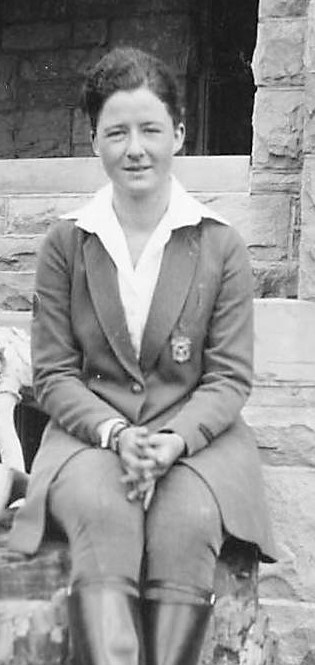
Women on the Ranger Force
Although discussions at the time referred to “officers and men,” uniformed women rangers also wore sleeve insignia based on their rank. As documented in Dressing the Part, the regulations applied to both men and women in uniformed positions. Available photographs don’t always show the presence of sleeve insignia, but there are enough photographs that do show them to demonstrate that this part of NPS uniform regulations also applied to women. Although the photographs aren’t usually clear enough to make out the type of patch worn, in most cases women had temporary appointments, and their sleeve insignia would reflect that.
Most uniformed women rangers in the 1920s worked at Yellowstone. Although there were many temporary women rangers at Yosemite as well, they were not uniformed and relied instead on The Authority of the Badge. The only known photograph of Lydia Barrette (Hawai‘i National Park, 1922) in uniform is a grainy one from a newspaper article. Although she is wearing a ranger badge and a temporary ranger uniform modified for the Hawaiian climate, her sleeves are rolled up. It's impossible to tell if she's wearing sleeve insignia. No photos of Helen Hagle Peck (Grand Canyon National Park, 1922) or Mary Sullivan (Glacier National Park, 1923–1930) working for the NPS have been found.
There are no confirmed photographs of Yellowstone rangers Isabel Bassett Wasson (1920) and Mary A. Rolfe (1921) on duty. Available photos of Marguerite Lindsley as a temporary ranger (1921–1923) don't show sleeve insignia. This is probably because the prescribed temporary ranger uniform called for a gray shirt and temporary ranger patch but not a coat. Lindsley is wearing her coat in all the photos from that time period, and she could be wearing sleeve insignia on her shirt. Although that can't be proved, the fact that she wears the other aspects of the prescribed temporary ranger uniform suggests it's likely.
Lindsley got a job as a permanent park ranger at Yellowstone on December 28, 1925. She held that position until resigning it on September 18, 1928, after she got married. She was hired as a temporary park ranger for two weeks in March 1929. She worked the summers of 1929, 1930, and 1931 as a temporary park ranger-naturalist. No photos of her from those later years are known, but it's assumed that she would have had to change her sleeve insignia to reflect the different position and status she held.
Only a few photographs of temporary ranger Irene Wisdom (1924–1930) in uniform are known. All date to around 1927 but none provide a clear view of her right sleeve. Margaret Thone (1924–1925) is probably the second woman in the photograph below, but her right arm isn't visible. The same photo shows a patch on Frieda B. Nelson's uniform (1925–1926). Given that they both worked as park rangers at the same time, it is reasonable to assume that Thone also wore sleeve insignia. There are several photographs of unidentified women in the Lindsley family collection that could represent Elizabeth Conard (1926), Francis Hodgin (1926–1927), Virginia Pound (1927), Ruby Anderson (1928), or other unidentified women at Yellowstone. One of them clearly shows sleeve insignia on her uniform.
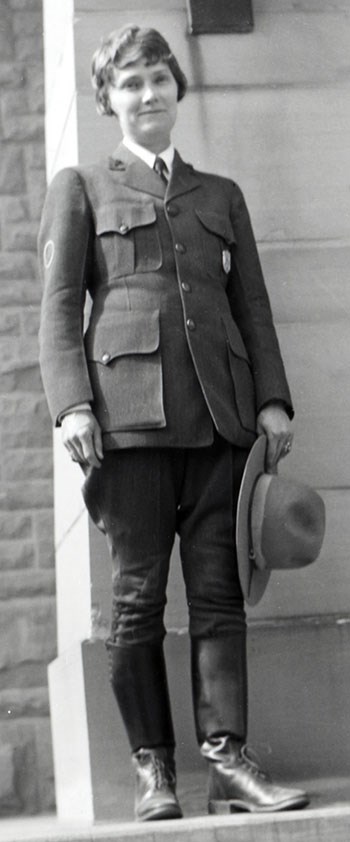
Photographs of Francis Pound (1926-1929) don't clearly show her right sleeve but her uniform was donated to Yellowstone's museum collection. It has a temporary ranger patch on the right sleeve. Pound's uniform is evidence that just because a photo doesn't show the sleeve insignia doesn't mean that it wasn't there. Given the number of photographs that show women park rangers at Yellowstone in the 1920s wearing sleeve insignia, it's reasonable to assume that they all did.
As noted, after 1928 only women park rangers and park ranger-naturalists would have worn sleeve insignia. Temporary ranger-naturalist Pauline Mead at Grand Canyon National Park (1930–1931) should have worn sleeve insignia. However, several photos of her in uniform clearly show her right sleeve with no insignia. Moreover, her uniform coat, in Grand Canyon's museum collection, doesn't have one. One explanation could be that although her official title was park ranger-naturalist, the superintendent considered her to be a naturalist, and the naturalist insignia had already been discontinued.
In contrast, a photograph of Dr. Margaret Fuller Boos, temporary ranger-naturalist at Rocky Mountain National Park (1928–1929), shows her wearing one. Although it can't be clearly seen in the photograph, the date would indicate she wore the ranger-naturalist patch.
Herma Albertson, temporary ranger-naturalist at Yellowstone (1929–1931) also wore sleeve insignia on her uniform, even before she was converted to a permanent ranger-naturalist position (1931–1933). The insignia can't be made out in the photo but based on her position, it should be the temporary ranger-naturalist patch. No well-dated photographs of her in uniform as a permanent ranger-naturalist are known.
Although few women were hired as rangers or ranger-naturalists in the large western parks after 1930, women rangers were hired in parks and monuments in the Southwest. One area that hired many women for uniformed positions was Carlsbad Caverns National Park. Although park guides didn't wear sleeve insignia, photographs show that some women there wore them—indicating that they worked as rangers or ranger-naturalists. Two of those women were Julia Dean and Jo Whitt Yardley. Both began at Carlsbad Caverns in summer 1932. A photo in the NPS History Collection show that both women wore sleeve insignia, but the patch designs cannot be clearly seen.
Dean is also wearing sleeve insignia in a 1933 photograph in the NPS History Collection. Interestingly, the other ranger-nurse in the photo, Nora Lee Hemler, and several of the men (referred to as rangers in the photo caption) don't have sleeve insignia. The photograph below features seven women guides and rangers at Carlsbad Caverns in May 1932. Although a June 1932 newspaper article calls Dean and Yardley "the first women guides" at the park, these seven women were there first. Unfortunately, none are identified. It's probable that the three women wearing riding breeches were rangers, while the women in skirts functioned as guides.

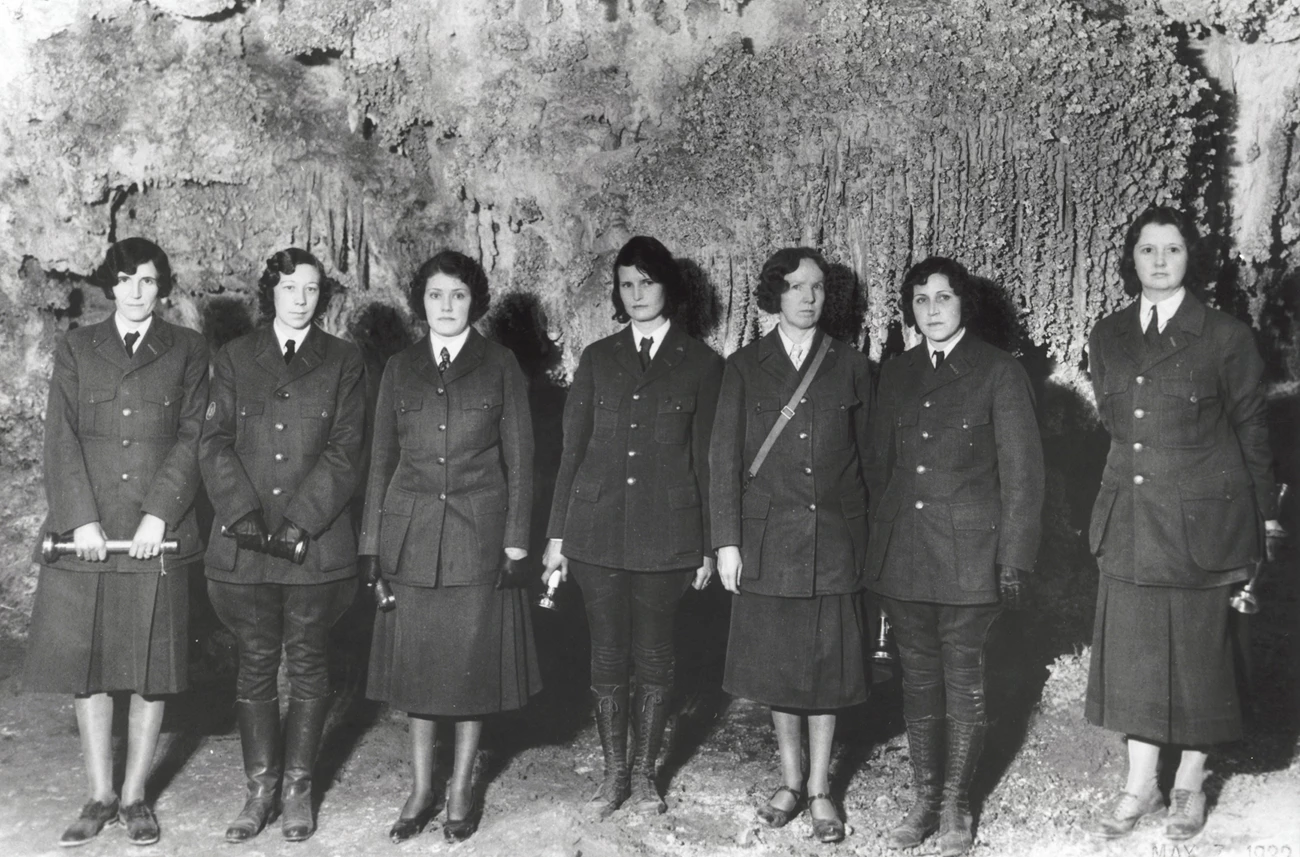
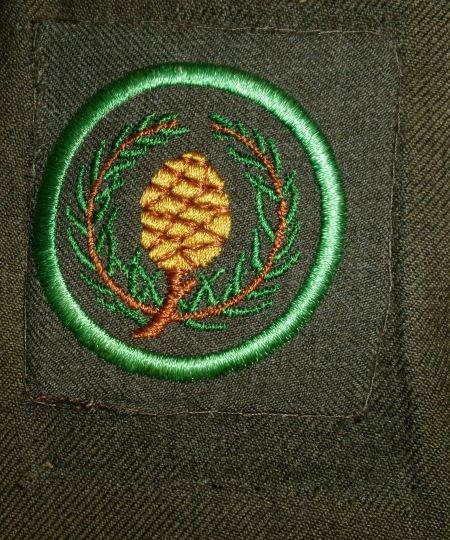
Holding onto the Patch
Sleeve insignia for the ranger force (chief rangers, assistant chief rangers, permanent rangers, temporary rangers, and ranger-naturalists) remained part of the uniform regulations into the early 1930s. At the 1934 superintendents' conference, it was decided that insignia for the rangers was an unnecessary expense that served no useful purpose.
Despite this decision, the ranger insignia remained in the 1936 uniform regulations. They may have been removed in 1938, but no copies of those regulations were found. When the 1940 uniform specifications were issued, ranger sleeve insignia were no longer part of the NPS uniform.
At least one photograph in the NPS History Collection indicates that some rangers continued to wear the ranger sleeve insignia until at least 1946. Employees had to pay for their own uniforms and, as a result, were allowed to wear older uniforms as long as they were "serviceable." Workman suggests that rangers may have continued to wear the sleeve insignia because removing them would have left a darker area of fabric. His inference is that removing the patch would have meant a costly uniform purchase. An earlier uniform in the Yosemite museum collection, however, suggests that the color change in the fabric wasn't always egregious enough to require a new coat.
It is well documented that World War II impacted the ability to get new NPS uniforms because wool, cotton, and other materials were needed for military uniforms. It was almost two years after the war ended before fabric and other clothing-related materials became available at pre-war levels. Perhaps a better explanation for the 1946 "outlier" photograph is that some rangers donned their pre-war uniforms when they returned from service in World War II.
Sources:
--. (2019). “Rationing Fashion in the United States.” Accessed June 3, 2023, at https://www.encyclopedia.com/fashion/encyclopedias-almanacs-transcripts-and-maps/rationing-fashion-united-states.
Assembled Historic Records of the NPS (HFCA 1645). NPS History Collection, Harpers Ferry, WV.
Pers. comm. (2023, May 26). Miriam Watson, curator at Yellowstone National Park, to Nancy Russell, archivist at the NPS History Collection, Harpers Ferry, West Virginia.
Pers. comm. (2023, June 6). Kim Besom, curator at Grand Canyon National Park, to Nancy Russell, archivist at the NPS History Collection, Harpers Ferry, West Virginia.
Workman, R. Bryce. (1991). National Park Service Uniforms Number 1: Badges and Insignia, 1894-1991. National Park Service: Harpers Ferry, WV. Available at https://www.nps.gov/subjects/hfc/upload/Badges-and-Insignia-R.pdf
Workman, R. Bryce. (1995). National Park Service Uniforms Number 3: Ironing Out the Wrinkles, 1920-1932. National Park Service: Harpers Ferry, WV. Available at Ironing Out the Wrinkles 1920-1932 (nps.gov)
Workman, R. Bryce. (1998). National Park Service Uniforms Number 5: The Developing Years, 1932-1970. National Park Service: Harpers Ferry, WV. Available at https://www.nps.gov/subjects/hfc/upload/No-5-National-Park-Service-Uniforms-The-Developing-Years-1932-1970-Table-of-Contents.pdf
